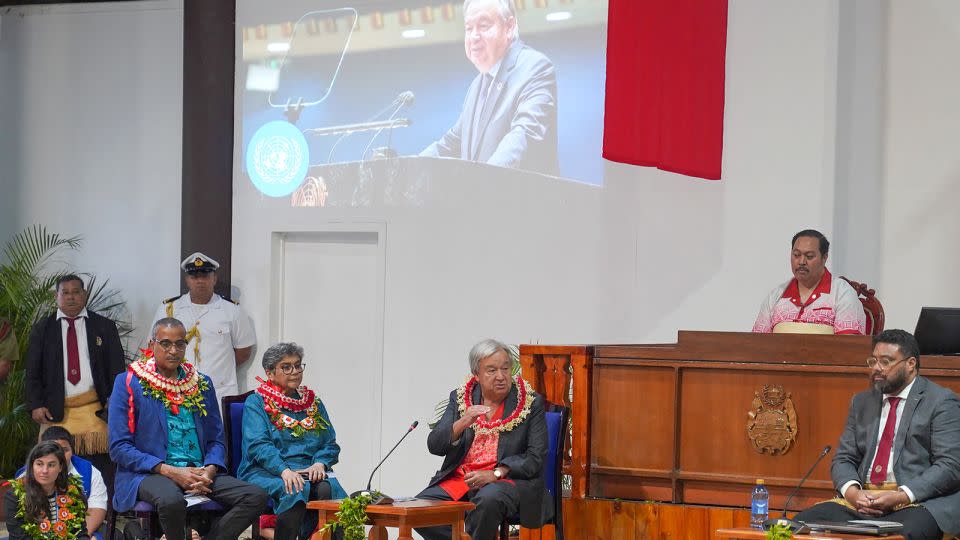A “worldwide catastrophe” is imperiling Pacific Islands and the world must respond to the unprecedented and devastating impacts of rising seas “before it is too late,” the United Nations chief has warned.
UN Secretary-General Antonio Guterres issued a global SOS – “Save Our Seas” – from the Pacific Island nation of Tonga on Tuesday with a plea to the world to “massively increase finance and support for vulnerable countries” in grave danger of the human-caused climate crisis.
“The ocean is overflowing,” Guterres said. “This is a crazy situation: Rising seas are a crisis entirely of humanity’s making. A crisis that will soon swell to an almost unimaginable scale, with no lifeboat to take us back to safety.”
Guterres’ dire warning was made at a meeting of the Pacific Islands Forum in the Tongan capital Nukuʻalofa, and coincided with the release of two UN reports detailing how the climate crisis is accelerating disastrous changes to the ocean.
Sea surface temperatures in the Southwest Pacific have risen three times faster than the global average since 1980, according to the World Meteorological Organization’s State of the Climate.
And sea levels in the region have risen at almost twice the global average over the past 30 years, it found.
In that time, the report said marine heat waves have doubled in frequency and become more intense and longer lasting.
Oceans have absorbed 90% of global heating, caused by humans burning fossil fuels that release heat-trapping pollution, the report said.
This ocean heating is boosting sea level rise, as water expands when it heats, and melting ice sheets and glaciers have added to the volume.

The most vulnerable
The Pacific Islands are being hit harder than most, suffering a “triple whammy” of ocean heating, sea level rise and acidification, which is harming ecosystems, damaging crops, contaminating fresh water sources, and destroying livelihoods.
Worsening floods and tropical storms are already devastating the islands. The report said that in 2023, 34 mostly storm or flood-related “hydrometeorological hazard events” led to more than 200 deaths and affected 25 million people in the region.
The ocean is “undergoing changes which will be irreversible for centuries to come,” said WMO Secretary-General Celeste Saulo.
“Human activities have weakened the capacity of the ocean to sustain and protect us and – through sea level rise – are transforming a lifelong friend into a growing threat.”
In a second report published Tuesday, the UN’s climate action team said the climate crisis and sea level rise “are no longer distant threats,” especially for the Pacific.
Pacific Islands account for just 0.02% of global emissions but are “uniquely exposed,” Guterres said.
“This is a region with an average elevation just 1 to 2 meters above sea level, where around 90% of people live within 5 kilometers of the coast, and where half the infrastructure is within 500 meters of the sea,” he said.


If the world continues its path of heating to 3 degrees Celsius above pre-industrial levels, the Pacific Islands can expect to see at least another 15 centimeters of additional sea level rise by 2050 and more than 30 days of coastal flooding per year, the report found.
In 2021, the Intergovernmental Panel on Climate Change concluded it is “unequivocal” that humans have caused the climate crisis and that “widespread and rapid changes” have already occurred, some of them irreversibly.
Tuesday’s report said, “emerging research on climate ‘tipping points’ and ice-sheet dynamics is raising alarm among scientists that future sea-level rise could be much larger and occur sooner than previously thought.”
Though Pacific Islands face “severe and disproportionate” impacts from rising seas, it is a global problem that poses “major risks to the safety, security, and sustainability of many low-lying islands, populous coastal megacities, large tropical agricultural deltas, and Arctic communities,” the climate leaders said.
Both reports call on global leaders to improve early warning systems for vulnerable communities, majorly increase funding for resilience and adaptation, and make deep, rapid and immediate cuts in emissions to keep global heating to within 1.5 degrees Celsius — a critical threshold that world leaders agreed warming should remain below to avoid catastrophic climate impacts.
“Surging seas are coming for us all,” Guterres said.
“The world must look to the Pacific and listen to science… if we save the Pacific, we also save ourselves.”
For more CNN news and newsletters create an account at CNN.com
Source Agencies

